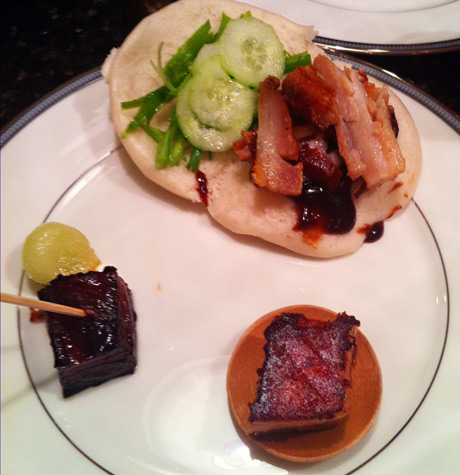The one question about wine I’m asked more than any other is “What’s your favorite wine?” The second most frequently posed question is “What wine do I have with…”? The first question is impossible to answer (I like a lot of wines), and the second question, I suggest, is mis-phrased. I think the real question should be “I have this wine I want to try – what food goes with it” rather than the other way around.
 Many once unyielding rules have been dismissed by modern wine lovers who have learned to drink the wines they like with the foods they like, assuming the sum of two pleasures has to be a good thing. In fact, there are reasons for some of the wine world’s rules, many of which are based on chemistry; it’s a lot easier to remember a few simple rules than the science behind them. Unfortunately, not knowing the chemistry, it’s easy to misunderstand the rule. Let’s think of the adages as guidelines and not rules – they’ll come across as a lot more flexible.
Many once unyielding rules have been dismissed by modern wine lovers who have learned to drink the wines they like with the foods they like, assuming the sum of two pleasures has to be a good thing. In fact, there are reasons for some of the wine world’s rules, many of which are based on chemistry; it’s a lot easier to remember a few simple rules than the science behind them. Unfortunately, not knowing the chemistry, it’s easy to misunderstand the rule. Let’s think of the adages as guidelines and not rules – they’ll come across as a lot more flexible.
I put the wine first because basically wine doesn’t change the taste of food, but food very definitely can change the taste of a wine. Take the old adage of white wine with fish and red wine with meat – a tannic red that is savory on its own will taste positively bitter and metallic with many fish, where (here comes the chemistry) there is neither fat not salt to balance the tannin. Cab with sushi? Disaster. Less tannic Pinot Noir with sushi? A little better, but the acidity can still be a problem. Non-tannic and fruity Riesling with sushi? Heaven. A lot of food and wine pairing guidelines are really aimed at preserving all the deliciousness of the wine on which you’ve spent your hard earned resources. I experienced a great case in point the other night.
For the past three years my friend Jamie Futscher and I have collaborated on and auction lot for the Miami Wine & Food Festival. Jamie is the wine buyer for Sunset Corners Fine Wine and Liquors and the possessor of an excellent palate. She’s also a wonderful cook and someone had the idea that given my background as a restaurant critic and Jamie’s as a sometime caterer, wouldn’t it be fun to pit us against each other – not only our cooking but our presumed skills at pairing wine and food. The resulting “competition” that for some reason has come to be called the “Wine Nuts Throwdown” surprised both of us in not only selling for a good price at the annual charity auction, but each year selling twice to meet the spirited (and let’s be honest, the spirit-fueled) demand.
Last Friday we prepared the first of the two dinners sold at the 2012 auction at the home of one of the festival’s patrons and a much admired wine collector. Given that our host had doing some autumn cleaning of her cellar, she came up with a number of wonderful wines that were each the last bottle of their kind in her collection. There were two wines from Sine Qua Non, the quirky Central Coast cult winery where Manfred Krankl indulges his passion for Rhone-style wines that are seldom made the same way twice. There were two 1995 Bordeaux, a pair of Champagnes (one in magnum, which definitely changes the wine’s profile over time), an American pinot noir, a bottle of the cult cabernet
Screaming Eagle, an extraordinarily well aged Port from a great vintage and a few other treasures. Our challenge was to find food to pair with the wines rather than the other way around. I’ll talk about some of our pairings and offer some wine tasting notes in future posts, but want to focus here on one in particular.

“Three Little Pigs”
A great example of “thinking outside the bottle” was finding a pairing for Jamie’s “Three Little Pigs,” pork belly cooked three ways. Each of the three approaches to the fatty meat had a degree of sweetness and that vagueness that always plagues pork – is it a red or white meat? The meat leans toward white, but the treatments, all three of which involved Asian flavors, varying amounts of spice and sweetness and pan searing, pushed the meat more toward the red end of the spectrum. Jamie and I independently arrived at the same solution: a wine with the good acidity and mineral flavor of a white wine, but a dense texture more typical of red and a hint of sweetness to balance the sweetness of the meats. The host had the perfect wine right there in the cabinet – a rich, almost unctuous Pinot Gris from Alsace. In the hands of a winemaker like Olivier Humbrecht, this Pinot Gris from the Grand Cru Heimbourg vineyard ends up almost oily in texture, with a ripe floral bouquet (a perfect foil for the Asian spices) and a bit of sweetness that, far from being cloying (as it might have been on its own) helped the wine stand up to the fat and to the sweetness of the glaze on the pan-seared pork belly.
On paper, I like pinot noir and Beaujolais with pork, but you can’t eat paper. You need to look at the ingredients in the food, abandon preconception about meat needing heavy wines and think instead about the basics – sweet, sour, salty, bitter and that most elusive of taste sensations, umami, the savory quality of food. In this case, all the taste elements came together by going with a white wine rather than a red. There were great reds on the table that night, but none would have gone with Jamie’s Three Little Pigs as well as the Pinot Gris. Or, more to the point, none of our other dishes would have gone as well with the Pinot Gris as did the pork.
I love the mysteries of how wine and food go together, and the only way to find ethereal pairings like this one is to practice, practice, practice. It may wreak havoc on your diet and cause you to reevaluate your exercise program, but it’s just about as much fun as a wine lover can possibly have.
© 2013 Lyn Farmer
